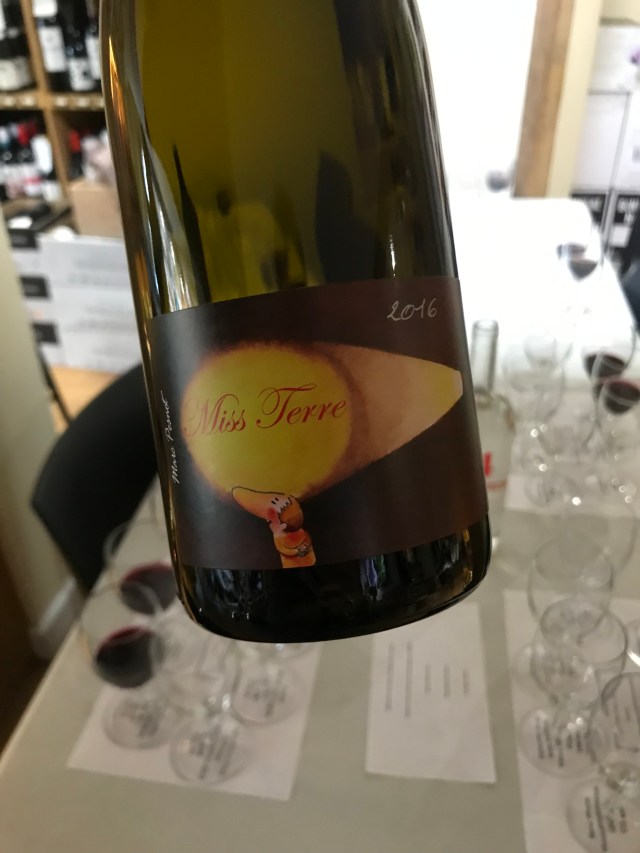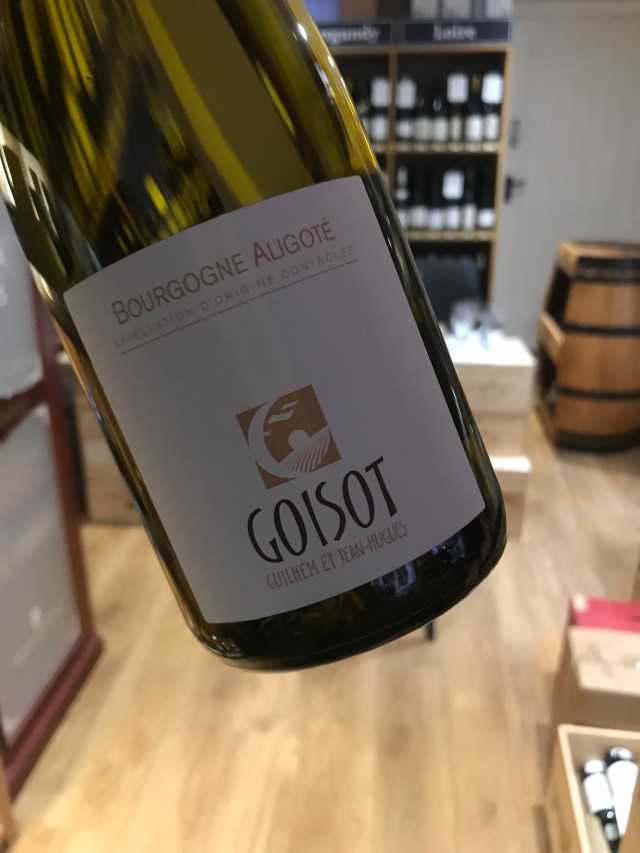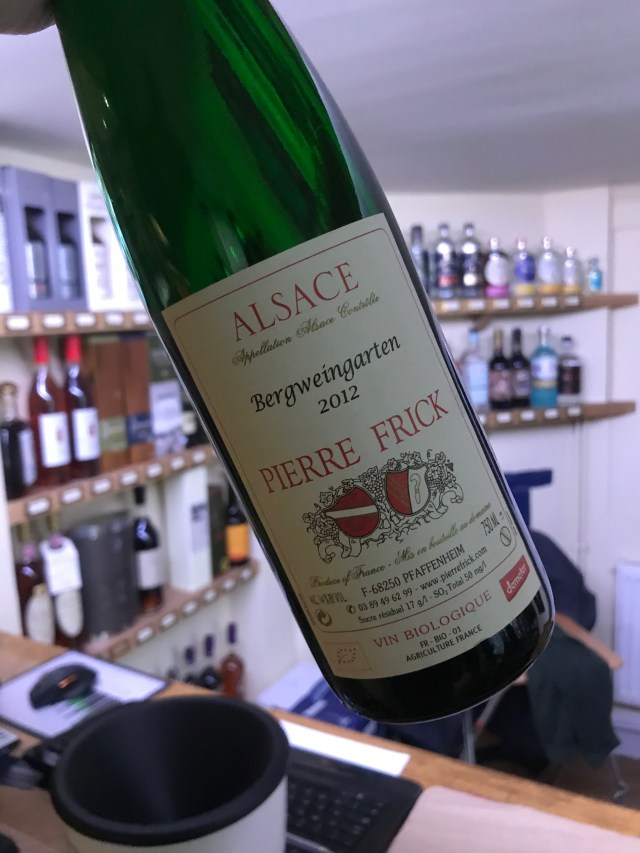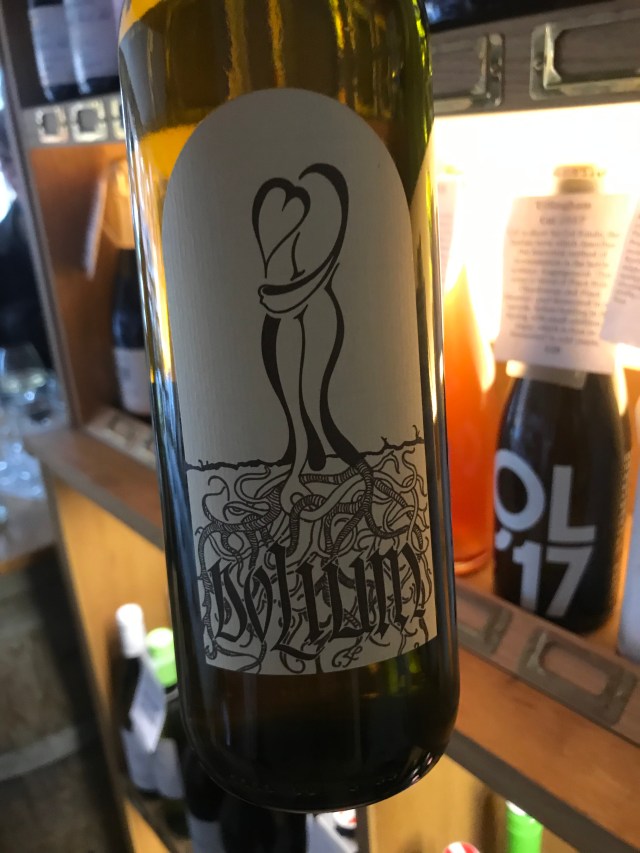Ugly Ducklings can be Swans! That was the title of the tasting given by Doug Wregg at Solent Cellar in Lymington on Friday night. Doug’s company, Les Caves de Pyrene, has proved that statement a thousand times over in the thirty-odd years that they have been importing wines often made using less fashionable grape varieties from all over the world. The premise of this tasting was that the most maligned grape varieties more often than not turn out merely to have been misunderstood.
Doug and I share much of the same philosophy when it comes to wine (and I rather suspect in many other areas too). My manifesto is always drink the most interesting wine, not the wine which some critic states with total confidence and certainty (and often arrogance) is the best. Forget scores. Look for what is in the glass rather than what supposedly isn’t. And, perhaps most importantly, remember that wine isn’t just, if at all, about grape varieties. It’s about the terroir, absolutely everything that makes that patch of land unique…and its about how one winemaker interprets that patch of land, whether with a single variety or a blend.
All of the wines here use grape varieties which have certainly been maligned, some even banned from use for fear that they would lower the reputation of their region. Yet there are gifted artisans who show year on year, whilst embracing the variation which different vintages bring, that wines of purity, beauty, excitement and many other things besides, can be created from these so-called ugly ducklings. To illustrate this Mr Wregg chose seven very different wines, and we were lucky as all of them shone on the night.
All of the following wines are imported by Les Caves de Pyrene, and Solent Cellar were taking orders on the night. They can obtain any wines from the Les Caves list for onward dispatch by mail order. Alternatively, visit the importer itself at Pew Corner, Artington, just south of Guildford (next to the Park+Ride).
René Mosse, Moussamoussettes (Anjou/Loire, France)
This wine is labelled as a non-vintage Vin Mousseaux – Brut Nature. It is essentially a pétillant naturel, a wine in this case without the addition of a dosage (Brut Nature) and with no disgorgement of the lees before sale. The grape mix blends the beautiful red Pinot d’Aunis with local workhorse (supposedly) Grolleau, both traditional varieties in the vineyards René and Agnès Mosse own at St-Lambert du Lattay, close to the River Layon in Anjou.
I well remember getting to know Terroirs restaurant and bar near London’s Trafalgar Square, back in the days when petnats were far less numerous. Moussamoussettes was our regular aperitif. I loved it, but (as I was reminded of with several wines here) if you are always excited by so many new wines to try it’s all too easy to forget to buy old favourites from time to time.
The wine in the glass is a lovely glowing cloudy pink, cloudy from the lees in the bottle, which we should embrace by inverting the bottle before opening to allow the wine to reach its full texture and flavour. The bouquet of red fruits (mainly strawberry and raspberry) is beguiling in its purity. The fruit has a sweetness, but the wine tastes more or less dry. This is a result of the bubbles, the balancing acidity, and the little bit of lees texture, I guess. It’s refreshingly (in both senses of the word) frivolous, and a perfect, cool, summer aperitif. So much more a picnic wine than Champagne, in my view. Expect to pay circa £25 retail.
Domaine de la Senechalière, Melon “Miss Terre” 2016 (Muscadet/Loire, France)
Marc Pesnot runs this thirteen hectare domaine from the village of St-Julien-de-Conselles, east of Nantes in the Muscadet Region. Melon, or to give it its full name, Melon de Bourgogne, is the grape of Muscadet, and has been since it was ejected (well, not quite) from its Burgundian homeland by Duke Philip the Bold (as an aside, there are a few producers of Melon in Burgundy, largely around Vézelay, the most well regarded being the Montanet family’s Domaine de la Cadette).
This wine is less of a “Miss terre-y” than its name suggests. Of course, Marc has not labelled it as a Muscadet, but largely because he considers most Muscadet to be an industrial product with which he doesn’t wish to be associated. There is another reason too. After his very old vines (up to 80 years of age) growing on schist are harvested, with extremely low yields for the region, they are fermented long and slow (for months, rather than the Muscadet average of two weeks). Following this, the wine undergoes malolactic, unheard of for AOP Muscadet.
The wine is pale. When you sniff it yields up very little, with none of the aromatics which laboratory yeasts give to the region’s main wine. This is a wine which is pretty much all about the texture. This is accentuated by the wine’s body. Not a full body as such, but a lot plumper than the thin wine which high-cropped Melon usually produces.
As a result, Miss Terre was totally misunderstood in France, where Muscadet is expected to be but one thing, and to be sold cheaply. The wine consequently made its way to Japan, where an appreciation of its savoury, food-friendly, qualities allowed Marc to sell the lot. Thankfully, some comes over to the UK. The French have realised too late that they are missing out. Retailing for around £19/bottle.

G & J-H Goisot, Bourgogne Aligoté 2017 (Auxerrois/Burgundy, France)
Guilhem and Jean-Hugues Goisot farm at Saint-Bris, near Chablis. The grape of AOP Saint-Bris is, of course, Sauvignon Blanc, but the Goisots also harvest the traditional Burgundian grapes of this northerly sub-region, namely Pinot Noir and Chardonnay, César and Aligoté.
Their other wines are very good indeed, and it would be hard to find a better Saint-Bris. But it was their Aligoté which piqued my interest in this variety perhaps twenty years ago. It was not remotely the acidic juice I’d found as a producer’s afterthought on the Côte d’Or, but something with genuine character and personality. I think it is Goisot’s Aligoté more than that of Monsieur de Villaine which spurred so many young artisans to make this grape variety into something exciting in recent years, perhaps “exciting” (with some notable exceptions) for the first time ever.
One of the keys to this Aligoté, as with so many superb wines from so-called lesser varieties, is old vines. In this case we have vines up to 90 years old, and none are much under fifty now. The yields of old vines are naturally low and so the juice will be concentrated. Pretty much nothing of note is done to the wine after hand harvesting. It ferments naturally in stainless steel vats, and is aged in the same material.
Even though this is a young wine (and I know it will age), it lacks any sense that it is an old style acidic Aligoté. It has a certain amplitude that would make you wonder whether they’d blended in 30% Chardonnay (of course, they didn’t). And there’s an abundance of elegance too. Yet at the end of the day it is also just a tasty gourmet wine, a far better accompaniment for river fish or a host of other dishes than a rich, buttery, oaked Chardonnay. It’s a wine which shares some of the mouthfeel of its neighbour in Chablis. Widely available for about £18.

Jean-Pierre Frick, Sylvaner “Bergweingarten” 2012 (Alsace, France)
This is another producer I keep forgetting to buy, these days (though I’m putting that right in a small way). This was one of the first domaines in Alsace to go organic (1970s), then biodynamic (early 1980s), and is now at the forefront of natural winemaking in the region.
Bergweingarten is a lieu-dit near the village of Pfaffenheim (south of Colmar and Eguisheim), consisting mainly of brown limestone with a little sand. The grape variety is Sylvaner, so abused that it was not considered fit for Grand Cru sites when those regulations were originally drawn up (there is light at the end of the tunnel for the variety in that respect, but perhaps an explanation should be saved for another time).
Yet a Frick wine is first and foremost a Frick wine. The old vine stock yields small quantities of equally small and thick skinned grapes here and the vineyard has a warm microclimate. The must is fermented long and slow in big old oak without fear of oxygen. Add to this the vintage, 2012 being a hot one in Alsace, and this cuvée is pretty unique.
The bouquet is herbal more than fruity. There is a slight oxidative note that merely adds complexity, something like a hint of spicy baked apple with orange, nuts and spice (cinnamon?). Every vintage is different, but with around 16-17 g/l of residual sugar in 2012 there is richness, though the sweetness is masked by fresh acidity that is there, but in the background, not in your face. The mouthfeel is lovely. It’s a softer wine than perhaps most Sylvaner you’ll taste. It was a very popular wine on the night…who would have thought that?
It’s very much one of those wines where you are advised to have a carafe handy, and serve it slightly chilled, but hardly at all. This well aged vintage will cost you £24. More recent vintages may be knocking around, especially in Paris, for a few Euros less.

Zorjan, Muskat Ottonel “Dolium” 2014 (Štajerska, Slovenia)
Yesterday I tasted wines from a unique producer, one who is a deep thinker. Wines can be unique for many reasons. In that case they were unique for the extreme type of natural viticulture used. In this case, the wines of Božidar and Marija Zorjan at Zgornja Ložnica, are unique for their ageing, and it is clear that Božidar Zorjan is also a very deep thinker.
At Zorjan, the “Dolium” wines are made in amphora (Dolium is a Roman word for this vessel). But Božidar believes that as wine begins life in the vineyard, that is where it should grow up. So the amphora (in fact, qvevri from Georgia) are buried out in the vineyard. Božidar also very much believes in the cosmic forces giving life to the wine as it rests below the planets and stars.
The Muskat Ottonel Dolium cuvée is made from vines which are 25-26 years old, planted on rolling hills at an altitude of between 400 and 450 metres. Božidar operates a closed farm. The idea is to create an ecosystem where everything works together. Manure comes from their own sheep, for example.
The wine is a pale orange, only just orange in fact. It does see a six month maceration, followed by 24 months ageing (twelve in buried qvevri and twelve in 1,200 litre old wood). In this vintage there were 1,000 bottles of Dolium Muscat made. The nose is complex, full of warmth. The palate has a genuine freshness, and it is unquestionably lovely, my wine of the night. Yet it is also a wine which confounds and confuses. Not an easy wine, you need to give it time to grow in the glass and to experience the changes which come.
This wine was pardonably served chilled. Personally I’d serve it cool at most, and certainly, as with the Frick above, pour it into a carafe if possible. This almost profound creation will retail for around £35.

Julien Guillot, Beaujolais “Les Pierres Bleues” 2015 (Beaujolais, France)
Julien Guillot is very much a cult name in France. His famous Clos des Vignes in the Maconnais was one of the first vineyards planted by the monks of Cluny. In that region he has lifted the Gamay grape from obscurity and mediocrity. This cuvée is from Gamay’s heartland. I don’t just mean Beaujolais. The vines are situated on a fault line which climbs up to the famous Morgon lieu-dit, the Côte de Py. The vineyard is largely limestone and sandy clay, but the Pierres Bleues are the blue volcanic rocks around the fault.
This is a dark and intense wine, which befits grapes from vines which are a hundred years old. Barrel-fermentation adds a little spice to the fruit and it has the weight of a warm vintage. There’s also unquestionably a degree of salinity which is rare in a lot of Beaujolais, and it certainly accents the freshness of the wine. But where it really scores is in its alcohol content, 12.5% (very low for 2015). There’s a lick of tannin, but energy as well and a genuine concentration of dark, and sour cherry, fruit. You might not guess the vintage.
This is a wine to age, but one which will also give great pleasure if drunk now. It’s about £32 retail.

Clos du Gravillas, Carignan “Lo Vièlh” 2015 (Languedoc, France)
Nicole and John Bojanowski farm their Domaine du Gravillas in the fortified wine country around the village of Saint-Jean-de-Minervois, yet they are not far, perhaps five kilometres, from the region’s famous red wines of Minervois. The wine is bottled as (for the English speaker) the charmingly named Côtes du Brian. The Domaine numbers around 8.5 hectares at just under 300 metres altitude on the Causse. The Clos itself is a white gravel moonscape, which Doug describes as “blinding” in the sunlight, dotted with the region’s elemental garrigue. The Carignan bush vines here were planted in 1911, so are now well over 100 years old. As so much Carrignan has been grubbed up and lost since the 1980s, this is a terrific viticultural resource which Nicole and John have preserved.
The beauty of this landscape lies in its close proximity to the Parc Naturel du Haut Languedoc, an area of protected mountain and garrigue hardly a stone’s throw from the vines, which benefit greatly from the cooling winds that descend from the peak of the Montagne Noir at night time, creating an unusually accentuated diurnal temperature range for a Languedoc vineyard.
Carignan’s reputation as a workhorse grape making high-yield red refreshment for northern factory workers belies its potential. With very low yields you can make good wine. With respect for the variety, John says, you can make great wine. Lo Vièlh sees the grapes destemmed and foot crushed, remaining on skins for six weeks. The result is a dark coloured wine, with an abundance of cherry and dark fruits, and then there’s a real hint of coffee and leather with spice adding an extra dimension. It’s also mineral and rugged. But at the same time there’s a smoothness which stretches throughout a long finish, somehow like rough and silky at the same time.
I used to buy this back in the early days of my affair with Les Caves, and it took Doug’s selection for this tasting to remind me what I’ve been missing for so long. I won’t deny that I’ve not bought a lot from Southern France in recent years. Lo Vièlh also has the advantage that, although not a cheap wine, [French] Carignan rarely commands the highest prices, however good they are. About £25 retail.

When I saw the list of the seven wines for the tasting I remarked that I’d be happy to be passed a glass of any of these. On the night they all justified that comment. I did only order a couple for myself, but I’d be more than happy to buy any…and I’m kind of having second thoughts about omitting the others.

Les Caves de Pyrene’s Line Moullier and Doug Wregg after one of the best tutored tastings you will go to, and clutching my wine of the night, too!








As an advocate of lesser known grapes I’d have enjoyed this so much. Hopefully get to try some at RWF next month
LikeLiked by 1 person
Thanks, Alan
LikeLike